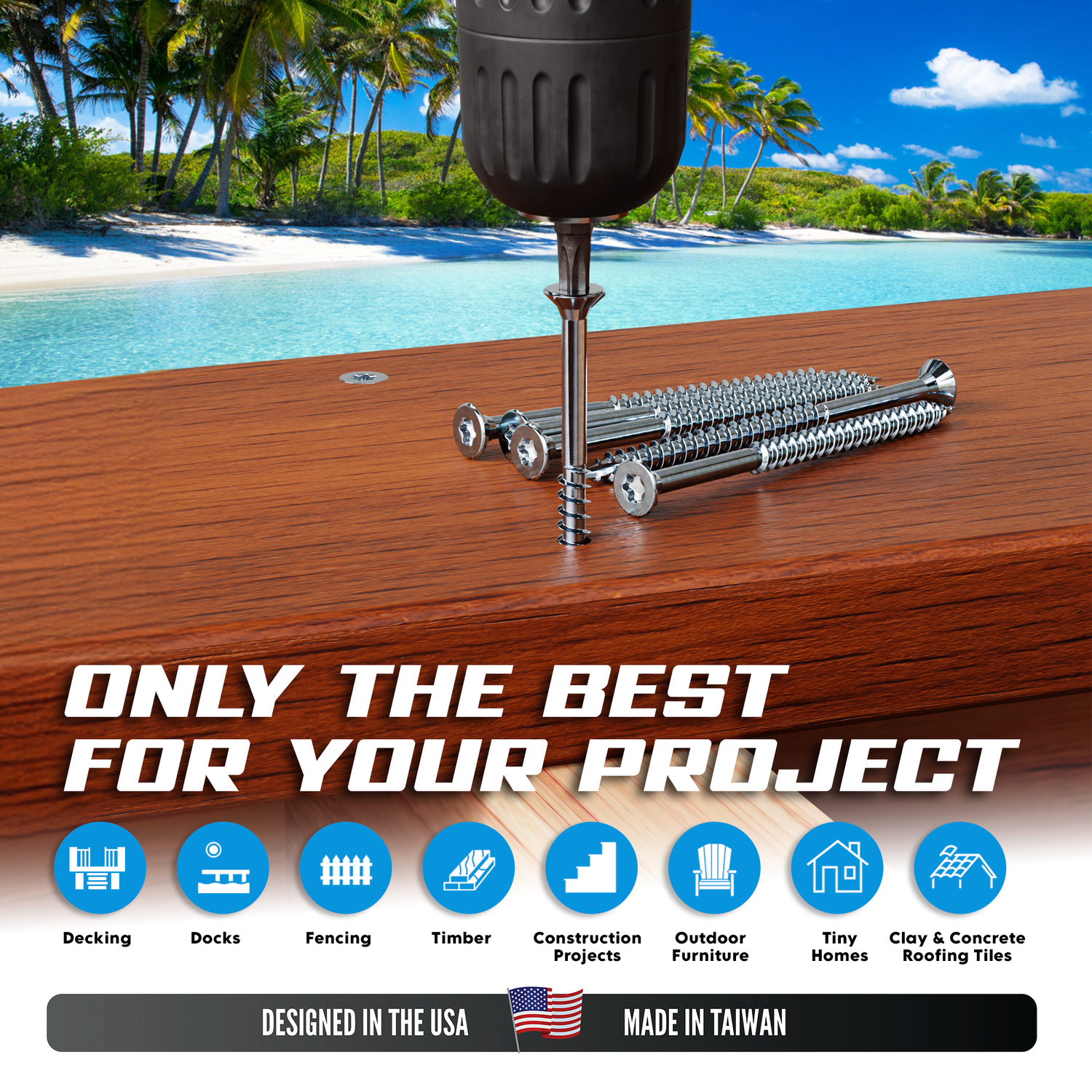
Do's and Don’ts of Building a Safer Deck (And Why Stainless Steel Screws)
Share
Building a deck might seem like a straightforward weekend project—you just build a frame and screw some boards on, right? In reality, there’s a lot more planning involved than most people realize.
Getting everything perfectly square, level, and plumb is critical. Structural components must be handled carefully, large materials require proper support, and special attention is needed to prevent water intrusion near the house. Even tasks like installing stringers can challenge even those with some carpentry experience.
Every step needs to be accurately done to make sure the deck is safe, durable, and built to last.
Here are the dos and don’ts of building a safer deck, highlighting why choosing stainless steel deck screws are worth it.
Building A Safer Deck: The Don’ts
Here’s what NOT to do when building a deck based on real-world mistakes that can turn your deck from safe to seriously unsafe.
Don’t Use Improper Footing Sizes (If You're Using Deck Blocks)
You need to know the load on each deck block. For instance, second-story decks hold a lot more weight than ground-level decks. You can’t just grab a generic footing block at your local store and expect it to last a long time.
Don't Ignore Frost Footings
Using footings that are too small or not deep enough leads to frost heave. When the ground freezes and pushes the footing up, it can eventually lead to misaligned posts, twisted beams, and cracked decking.
Don’t Let Posts or Stair Treads Sit Directly on Concrete
Posts and stair treads resting on a concrete pad can start to rot pretty quickly since the end grain soaks up water like a straw. Try using lag bolts with hex heads to lift and level the posts above the concrete so they stay dry.
Don’t Over- or Under-Size Your Beams, Joists, and Framing
Make sure everything is in the right size for the span and load. For instance, you can't use regular lumber to cover 16 feet according to the code. When these deck components are over-spanned, they'll start to sag and bounce, which can make your deck pretty unsafe.
Don’t Space Joists Incorrectly
If your joists aren't spaced right, especially with composite or PVC decking, your deck will flex and bounce like a boat on the water. Follow manufacturer recommendations, typically around 16 inches apart, or even 12 inches if you're laying the decking at a 45-degree angle.
Don’t Support Deck Planks Directly with Posts
The post should go up under the floor joists, which help carry the load down through the post to the ground.
Don’t Use 1x6 Boards for Stair Treads
Even with a bull nose, 1x6 boards can’t cantilever far and will crack under pressure. Use 5/4 or 2x6 boards that are pre-milled with a rounded edge because they can handle foot traffic much better. Installing a solid timber riser is a solid way to make treads strong and safe.
 Don’t Install Stair Treads Tight Against Risers
Don’t Install Stair Treads Tight Against Risers
Leave a small gap of about 1/4 inch at the back of your stair treads. This will help keep them dry and stop rot from forming where the tread connects with the riser.
Don’t Overdo the Cantilever on Joists
Cantilevering joists by only two inches is almost pointless. It looks good, but it's a better idea to raise the beam and connect the joist right to it instead of using a small cantilever.
Don’t Bolt Railing to the Rim Joist Without Proper Support
If you bolt your railing straight to a rim joist that’s only nailed at the ends and doesn’t have hurricane ties or strong connections, it will end up pulling away. This is not safe and is a frequent error that makes your deck structure weaker.
Don’t Nail Everything Together
Nails tend to pop out over time, particularly on decks that are exposed to the elements.
Don’t Use Galvanized Nails in Pressure-Treated Wood Areas
Galvanized nails hold moisture and rust quickly, especially where water pools, so avoid using them in these areas.
Don’t Install Deck Boards Too Tight
Especially in rainy climates, you need spacing to promote water flow. If you don't, the decking can begin to rot after a while.
Don’t Build Without Proper Ledger Attachment and Flashing
Make sure you don’t connect your deck’s ledger to the house’s first-floor joist without using flashing, house wrap, or metal flashing. To install it correctly, you need to take off the siding first. Then, put in the flashing and secure the ledger with flat washers to allow for airflow. Finally, cover everything with another piece of flashing that is bent over the fascia board.
Don’t Skip Proper Ventilation and Run-Off for Ground-Level Decks
If there isn't enough airflow, moisture can get trapped under the deck, leading to wood rot, mold, and damage to the structure. If water doesn’t drain properly, it can collect around the posts and beams, which can cause decay and make your deck’s foundation weaker.
To prevent plants from growing underneath and to keep moisture from pooling, install a weed mat or ensure there’s good drainage under your deck.
Building A Safer Deck: The Do's
Here’s what you absolutely have to do to ensure you’re building a safer deck. These are what our experts do consistently, carefully, and confidently to create decks that last and keep you safe.
Do Use Flashing Tape and Metal Flashing
Flashing tape is essential for keeping your beams and joists safe, especially if you're using composite decking that outlasts the framing. Flashing helps keep water off the wood, which means your structure lasts longer.
Metal flashing is vital for keeping your house siding and ledger board safe, helping water drain off so it doesn’t lead to any rot.
If metal flashing isn't an option, deck spacers work really well to keep the airflow going and help with moisture drainage behind your ledger board, which stops any moisture from getting stuck and causing damage.
Do Know How to Square Up a Deck
To make sure your deck is square, use the 3-4-5 method or cross-dimensional measures. This is very important for a neat, professional look and to make sure that things like picture frame decking and mitered corners fit properly.
Do Use Joist Tape to Protect Structural Lumber
Apply G-tape (a peel-and-stick flashing tape) on top of all joists and beams to protect the wood from moisture where the decking sits. This is an easy and cost-effective step that helps to extend the life of the framing.
Do Connect Joists Positively with Hurricane Ties
Hurricane ties, such as H1A’s, are used to firmly attach joists to beams. This helps stop any movement and makes the deck frame stronger against wind and weight.
 Do Use Proper Fasteners
Do Use Proper Fasteners
Use structural screws that have engineered ratings, like Strong Tie Timber screws. It's best to avoid using random nails or any fasteners that aren't approved, as they can compromise strength and safety.
Deck screws have these threads that hold onto the wood, making sure your deck boards remain secure for a long time.
Do Seal Cut Ends of Deck Boards
When you cut your decking boards, make sure to run some oil or sealer along those cut ends. This keeps moisture from soaking in too much, helps reduce cracking, and gives your deck that polished, professional look.
Do Think About Deck Size and Positioning
Don’t just build the biggest deck you can afford. Consider sun exposure, wind direction, furniture placement, and whether adding a roof or wind barrier could make your deck more comfortable and usable all year long.
Do Use Properly Sized Support Posts and Joist Hangers
When it comes to support posts, you’ll want to go with at least 4x4 (which is really 3.5" x 3.5"). But if you’re building an elevated deck, it’s better to use 6x6 posts (that’s 5.5" x 5.5") since they’re way more solid and durable.
Make sure to secure your joists using metal joist hangers whenever you can. Even when the joists are hanging over a beam and hangers aren't required, it's still a smart move to use them for some extra support.
ABSOLUTELY Do Invest in Stainless Steel Screws for Lasting Strength
Do choose stainless steel deck screws. They might cost a bit more, but you won’t have to worry about rust bleeding out and ruining the look or strength of your deck.
Investing in stainless steel means your deck stays strong, safe, and beautiful for years without the hassle of corrosion or fastener failure.
When it comes to building a safer, longer-lasting deck, stainless steel deck screws are the ultimate “do” that delivers peace of mind and premium durability.
Don’t settle. Do make the smart choice for your deck’s foundation.



